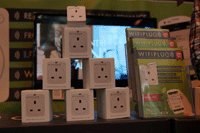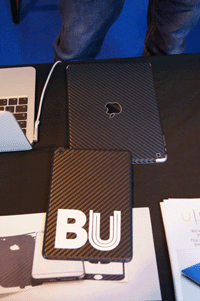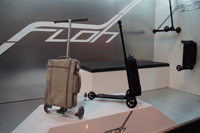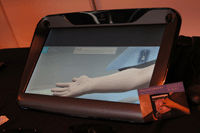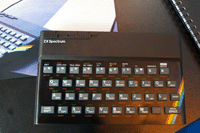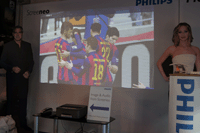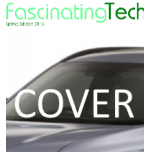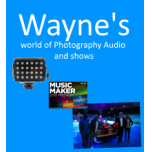Wayne's world of Photography and Audio - Fascinating Tech Magazine
Main menu:
- Home Page
- Editions
- Spring 2015
-
Older Issues
- Holidays 2014 Issue
- Autumn 2014 Issue
-
Summer 2014 Issue
- Summer 2014
- Editorial
- FascinatingTravel -AirWheel Special
- FascinatingGadgets - QI wireless Charging, Low cost router and CrazyTalk
- FascinatingTravel - Safety, recharging and more
- Fascinating Home - Computer Lights! - Voice controlled Home Automation VoxCommando
- FascinatingAudio - Nakamichi AV1 + AV1P and Edifier Connect Extreme
- Competition - win great prizes from Energizer, Edifier, STM, Honestech, WebsiteX5 and more
- Spring 2014 Issue
- Holiday 2013 Issue
- Separator 2
- Reviews
- Separator 4
- Privacy
Wayne's world of Photography and Audio
Spring 2015
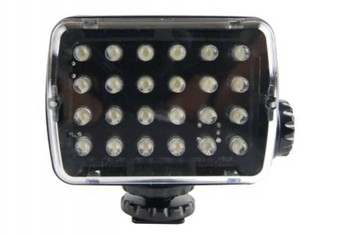
Photography, Audio and a Show
with Wayne Watson
Every Photograph need good lighting. In this month's article Wayne looks at a really good light source from Manfrotto. He also introduces the first in a  series of articles on Magix's amazing but complex Music Maker product and finally takes a wander around the Gadget Show
series of articles on Magix's amazing but complex Music Maker product and finally takes a wander around the Gadget Show
 series of articles on Magix's amazing but complex Music Maker product and finally takes a wander around the Gadget Show
series of articles on Magix's amazing but complex Music Maker product and finally takes a wander around the Gadget ShowManfrotto ML240 Continuous Light

Product Details
· Model ML240
· Unit LED Light - Mini-24 Continuous (220lx@1m)
· Power 2 x AAA batteries (not included)
· Output 5600˚K (daylight), 220Lux @ 1m \ 84 lumen*, variable control
· Duration ~40 minutes continuous at full power*
· Dimensions 8cm (wide) x 5.5cm (high) x 3cm (deep) (widest points) x 119g (weight)
· Construction Plastic
*=From manufacturers web site
In the box
· ML240
· Instruction manual and guarantee
Attachment to camera
· Most cameras - Slides into standard hot-shoe adapter
· Sony Alpha - Requires a Sony to Standard adapter (Such as the Pixel TF-325 powered adapter which I use, others are available)
Looks
The unit is made from slightly textured black plastic on 5 sides, with a clear polycarbonate \ plastic facia covering the 4 rows of 6 LEDs. A small orange LED nestles on the bottom that slightly illuminates the camera controls when the device is powered up. Also on the bottom end is the slot which the supplied hot shoe connector slides into for attaching to the camera.
The back panel has the Manfrotto logo embedded into the battery cover which is easy enough to open up to access the home of the 2 x AAA batteries it needs for power.
The left side (when viewed from the back) has a rotary switch that powers up the device and sets the power output. Being analogue, the user has a lot of control over the power output. Helpfully the dial has 4 symbols on the cardinal points for off, low, medium, and full power. At lowest power, a useful amount of light is produced with full power being painful to look at.
There are heat \ glamour vents on all four sides but I never noticed the unit getting hot in use.
Attaching
Connection to the camera is via a supplied double-nut screw - One end slides into the light with one night to lock it in place, while the other end slides into the hot-shoe mount with another nut to lock it in. For most users this is a painless exercise, but for those using non standard hot-shoes, this will not work. For the Sony Alpha range, a non-standard shoe is used. This means that the user has to attach the light another way or shell out for an adapter. Lots of manufacturers make Sony adapters and I plumbed for one from Pixel. £10 got me a powered adapter that can be used to power up non-Sony flash units - The light only uses power from the 2 x AAA batteries.
In Use
The light is very light, only 119g (- batteries) and the weight is basically unnoticeable when attached to the camera. The power control is easily accessible on the left hand side and the single down facing LED does illuminate the camera controls slightly which is a nice touch (simple things make all the difference). The light produced is very good - A constant and steady light source with no flickering or wavering that I have seen with other \ cheaper units (and I tried a few).
There is no heat felt from the numerous LEDs but this may be due to me typically using it on its lower settings for short periods of time.
The device locks solidly onto the camera and can take a few knocks and bumps without shifting position, even when attached via an adapter adding another 25mm on the height of the unit.
Lifting the ISO
I have mainly been using the light providing photographic during paranormal \ ghost-hunting sessions where existing illumination is either non-existent or so low that it needs additional lighting to improve the ISO measurements of the camera. Flash photography here is not banned but it breaks the atmosphere. As these sessions are usually conducted in dim and dark houses or tunnels, the ambient light from torches and the elements provide just enough output for my camera to pick up on but at the expense of very high ISO (12,800 at times). Using this light to softly illuminate the area allows me to drop this down to 400 (or even 100 with use of a tripod) without breaking the mood or reflecting off dust or other debris in the air.
Fill in lights
The other times I have used the light is when providing some front fill lighting in order to lift the subject without over exposing it. Flash would work here but I personally like continual light - I can see the effects through the view finder as I am composing the shot - I do not have to take as many test shots as I think I would with flash.
Upsides?
It's another neat looking device from Manfrotto that has a definite use in my shooting workflow. It's lightweight, portable, bright, and the batteries have lasted through 3 night shoots and 2 studio sessions. As a controllable always on light source it works very well indeed.
Downsides?
Being plastic it could get scratched or knocked in use, but (1) I have not had this happen yet a (2) it's a relatively cheap device so not a great loss if damaged.
As I sometime photograph in dusty or dirty locations, dust can get into the light via the heat \ glamour vents, but again, this has not seemed to have happened yet and should not impair the units workings. In these instances, I am also more worried about dirt getting into my camera - Need to be very careful in these situations.
Summary
The ML240 provides a clean and steady light source for those times when a flash unit is undesirable or unavailable or when additional lighting is required. The unit has both larger and smaller siblings, but this one combines the small size and adequate lighting needs I require. With 24 bright white LEDs, an analogue brightness adjuster and running on 2 x AAA batteries, the unit has been used on multiple occasions to lift the ambient light enough to move to a better ISO on my Sony Alpha. Like the Manfrotto 055 tripod, it has become a core piece of my equipment and has its own pocket in my equipment bag.
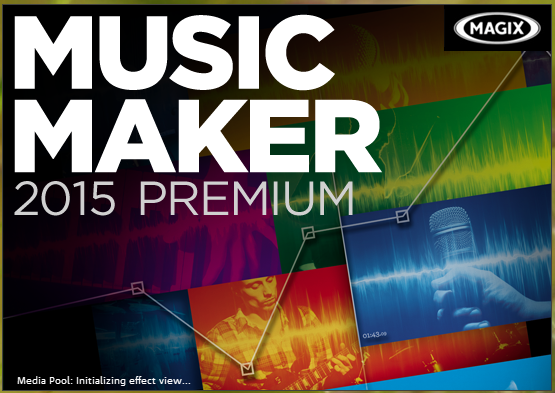
Magix Music Maker 2015 Premium
Summary
This is the latest version of the popular music sequencing \ making software from Magix. it has evolved a lot since I last used it (4 years ago) and seems to be aimed at a much more (semi-) professional audience than before. With up to 99 tracks and 48 KHz sampling and a wealth plug ins available this is a beast of a product. All the "quick start" tools appear to be there but it also seems a lot more heavy-weight \ heavy-going.
This will be the first of a multi-part review of the product, concentrating on the installation.
Product Details
· Software Magix Music Maker 2015 Premium
· Version 21.0.2.33 (UDPP3) - Update available \ not installed during part 1 of review
As Installed
· Main software, License key
· 6,000 sounds and loops over 10 genres
· Mastering suite, Midi editor, Publishing tools
· VST support & plug-ins
· Flutes, Drums, Analogue synths, Harp, DN-ei synth, Beatbox, Vita Sampler, Drum engine, Jazz drums
· Sound effect wizards
Key software installed by the installer
· Magix Music Maker Folder ~ 480MB
· Inclusive Sounds ~ 900 MB
· Additional 1,000 sounds ~ 152 MB
Bundled and optional, but defaulted to "Yes, install"
· Simpliclean ~ 60 MB required
Specifications & Requirements
The following is taken from the box \ website and worked well enough on my second generation i3 + 8GB RAM
Recommended Minimum Hardware (4K videos require higher specification)
· CPU 2 GHz
· RAM 1 GB
· HDD 4.2 GB
· Sound card 16 bit
· Graphics 1024 x 768
· Internet Required for licensing \ registration and uploads
· Can be used offline, but requires internet connection once per month to validate key
Supported formats
· Import WAV, MP3, Ogg Vorbis, WMA, AIFF, QuickTime, MIDI, CD-DA , BMP,
JPEG, AVI, MXV, WMV
JPEG, AVI, MXV, WMV
· Export WAV, MP3, Ogg Vorbis, WMA, AIFF, QuickTime, MIDI, CD-DA, BMP,
JPEG, AVI, MXV, WMV, MP3 Surround (Premium-Version)
JPEG, AVI, MXV, WMV, MP3 Surround (Premium-Version)
· Interfaces ASIO, VST, Rewire, DirectX
Summary
This was my first foray into audio sequencing for 5+ years after experimenting with Magix Music Maker (5?), EJay, Acid Pro and others. It came about after finding one of my tracks while reviewing Magix Photo Studio Deluxe (last issue) and the editor kindly sourcing a new version for me.
My memories of the earlier Magix Music Studio (MMS) were of
· Fun
· Speed
· Quick turn-around of 'good' tunes (subjective)
· Drag and Drop functionality
· Vast selection of samples to play around with
My prior effort was mainly spent on listening to the supplied samples, adding a little reverb or sound reversal and arranging them into sequences I liked; typically a number of individual elements building on top of each other until a crest is reached; followed by either a big drop (bass crash) or into a single refrain that carries the theme - Apologies to proper musicians out there - these may not be the correct terms, but ones that sound right to me.
Old attempts at tunes (not music, definitely not music) can be found here:
Installation
A slightly elongated installation process.
By slightly, I mean 'very'.
By elongated, I mean 'very'.
By installation process, I mean 'installation, check, reinstall, add more, then more, then restart, then install more' process.
This could be due to using a reviewers version of the premium product and slow connection speeds somewhere in the ether at times, but overall, with normal length gaps between install steps, a 160 Mb/sec download speed (thank you 'Big Kahuna') I still had 4 hours of downloads and installs and 40 + install screens to go through, most, but not all, visible at :
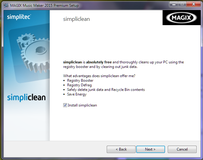
Some of this was to be expected, others were not. When an instrument was access for the first time, the package needed to be downloaded. When I pulled down one set of updates, it found an update and then pulled that down too.
Thanks heavens I saw the bloat-ware offer (Simpliclean) and excluded it else even more downloads would be needed. (Note, it's easy to miss and is SELECTED by default )
In Use
The main UI has not changed much since the earlier version I used.
· Audio tracks arranged on the left (up to 99 of them)
· Time \ Bars organised across the top (collectively known as the transport)
· Bottom part of the screen providing access to the sound-pools and other tools.
· Other tools popping up as needed, or ...
· ... snapping to the lower part of the screen (such as the keyboard)
It's all familiar, and simple to use, or easy enough to guess what to do. It's quite intuitive and logical in the main, but you can lose yourself in it. As a beginner, this may be annoying, but as a user with more than an hours' knowledge, it's no big deal - Everything is easy to access to put away.
Music Maker 101
· Launch the application
· Bottom left - Click on Sound Pools, then select a style (60's Soul)
· Click on an instrument (Bass)
· Click on a sound (Bass Master)
· Click on a pitch (was 6, select 1)
· Drag the Bass Master sound to first empty slot \ position on the transport
· Drag the right hand edge to the right to cover 16 bars
· Row 2, select Guitar > 2 Guitars, add in column 5, and stretch for 4 bars
· Ctrl + click and drag it to the right (take a copy), make it 2 bars long, click on the little down arrow on the bottom right of the icon, and select "set 2 pitch"
· Click on the first Guitar 2 icon again, ctrl+ click it to right (it keep original pitch)
· Row 3, select Bass > Upright, drop in column 1 and stretch for 8 bars
· Click \ copy to the right for 2 bars, and again set pitch to "set 2 pitch)
· Click copy the first icon to the right again
· Penultimate - row 4, column 12, add Percussion > Cymbals D
· Finally - Row 5, column 12, add Vocals > Adlibs D_3
· Press play !

There is a WHOLE lot more, and the tools and techniques will be in part 2 of this review.
Gadget Show Live 2015
Summary
My first Gadget Show Live experience which unfortunately did not live up to expectations. If you wanted a 3D printer, a quad- \ multi-rotor copter, or personalised cases for your tech, then the show had you covered... This was not say the show was bereft of anything interesting but there was nothing from expected big names - not even a presence. Microsoft, LG, Sony were all absent, but HP, Pebble, Dyson, Korg, Swann and a number of smaller companies were showing off their wares.
I know it wasn't a consumer show per-se, but I still expected some of the larger phone, television, and service organisations to be around - With rapid take up of 4K television and video, and with a swathe of new mobile devices being pushed, it was all conspicuous in its absence.
Break down of the press day
Photo call
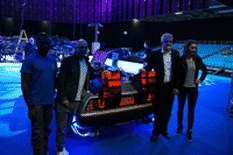 A chance for the press to meet up with the Gadget Show presenters in the presentation auditorium. Jason, Ortis, John, and Amy were all present along with a replica "Back to the Future" DeLorean, and about 30 press. Jason and the team spent a few moments together and individually talking about the show and meeting \ greeting before Jason wheeled out the DeLorean with the help of a few of the crew members. With a press (no pun) of people trying to take shots, I used my Sony + Tripod + Shutter release to take a few high shots before moving back to the main hall.
A chance for the press to meet up with the Gadget Show presenters in the presentation auditorium. Jason, Ortis, John, and Amy were all present along with a replica "Back to the Future" DeLorean, and about 30 press. Jason and the team spent a few moments together and individually talking about the show and meeting \ greeting before Jason wheeled out the DeLorean with the help of a few of the crew members. With a press (no pun) of people trying to take shots, I used my Sony + Tripod + Shutter release to take a few high shots before moving back to the main hall.Packed Pixels
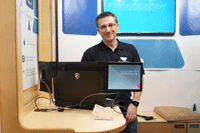
First stop was to Packed Pixels, offering Retina spec'd displays that plugged into, and onto laptops, allowing portable multi-monitor functionality for the user-on-the-go. The devices were high quality affairs, in build and display, which sat inside holders that connected to the laptop (or other device) screen.
Able to freely flip between landscape and portrait orientation, and swap between facing the audience and the user they seemed quite versatile and simply done (I like simple and well done). As secondary \ tertiary monitors for a user I can see a good market for these (depending on final price), but as something that could be shown to an audience, this would only work if the audience were close to the monitors -being 11" diameter, the ability to clearly view whatever was being presented could prove a challenge, no matter how good the DPI. The devices require use of a USB port and a display port so you may need a USB hub if you present with a lot of accessories.
WiFi Plug
Next up was WiFi plug, a UK spec'd plug and socket that allowed the control of almost any electrical item in your home that plugs into a socket - So long as you have Wifi and \ or 3G\4G connectivity - And who doesn't.
Marketing says "Buy a WiFiPlug, Download the App, Create an account and control". Again, a nice and simple idea that appears well executed. You can plug items into the WiFi plug then into a normal wall socket and be able to control that via an app over WiFi (Sitting in bed, turn on the coffee percolator while you get dressed), or from abroad (use 3G to power up the sprinkler system that you forgot to put on a timer). Currently the system makes use of your personal account in Amazon Secured Cloud (guaranteed to be available for 5 years) , but this could change to something else as demands dictate.
The application allows for advanced users to write their own applications to control objects plugged in to the system... This is good because opening up an API allows for others to take the application forward in areas the original designers did not envisage or plan for (this early), but on the downside this could be abused by people for nefarious purposes. Just looking at the forums I see examples of help where it mentions "Try Telnet port 23 with password 000000" - How many users will bother to change the password if not forced to; This could lead to an over-eager developer suddenly gaining accidental access to someone elses devices - Especially as a number of people also forget to password protect their WiFi.
I have not read the full documentation on the device so I may be well off the mark here - but for devices where security is as important as convenience, consumer devices, or where actions are left to the consumer, convenience tends to come first; IE, they leave security settings at their defaults.
UKarbon
UKarbon are 2 Bournemouth Universtity students "with a love of carbon" . They source carbon fibre matting from 3M in order to produce high quality skins for current tech - laptops, phones, and now even mice). The items look NICE and fit extermely well, but note: these are not hard-cases or shells. They are easily attachable, great looking, thin but tough skins that are attached semi-permanently to a number of supported devices. They CAN be removed, but not as easily as a cheaper detachable skin or case. As an ex-student, trying to balance work and college was hard - As these guys have found an avenue for their passion AND continue with their dissertations, give these guys a look and see what they can offer.
Floh
I didn't spend as much time as I wanted here - Floh offered bi-pedal, or uni-pedal, locomotion enhancement services combined with enhanced carriage capabilities with 0% dependency on modern telecommunication techniques.
Basically, it's a 3 wheel push-along scooter with a detachable suitcase. It looked FUN.
For a family holiday, I can't see mum, dad and the kids having one each, and the occasional traveller may not wish to spend the money on what they could consider a novelty, but I CAN see these being used by people who do a lot of individual travelling (business people who have mastered the art of single bag travelling) who know where they are going at the airport and wants to get there quickly.
The device looks very manoeuvrable and steady which will be important to those using them. The handlebars are tilted back nicely so that the whole unit stand upright on its own, even with a full suitcase. The downside may be the extra few pounds of weight when the unit has to be carried - No skateboarding at the airport will also include no skating with suitcases shortly I fear.
Touch Surgery
Developed and designed by ex-surgeons and other medical professionals, this team provides FREE access to professionally written and well executed surgery simulation software - from pre-incision, to post-op processes. The team work on feedback received from users (typically surgeons and med students) to continually improve the software.
Feedback on their blogs show a lot of enthusiasm and support for the products by people with more letters after their name than I do IN my name. The team at the show were passionate about their product and enthusiastic about the future.
Elite ZX Spectrum
I spent far too long at this stand, caught up as I was in memories of soft rubber keys, oft times loose power connections, and 8 bit strains of "In the hall of the mountain king". The ZX Spectrum 48K was my third home computer, after my ZX80 (needed assembly), and ZX81.
Elite have faithfully reproduced the iconic home computer unit at full size, which operates as a wireless controller for use with iOS (and selected Android) devices, games, and apps. During the hands on demo we saw a recreation of "Chuckie Egg" running on iOS, being controlled by the Spectrum unit; IE - Do not expect a working ZX Spectrum... This is a controller that can interact with recreated Spectrum games on modern devices over Bluetooth. The applications available include Chuckie Egg, Manic Miner, Jet Set Willy and Spectrum Basic. The incentives that come include an API allowing developers to write their own apps and keep royalties - Brochures on the web site have all the details (still Beta).
Phillips
Phillips were presenting their ultra-short throw projectors with one device situated approximately 0.5 meter away from the wall and generating a crisp, non-distorted 2 meter wide, high-definition image on it. LED Technology is used to project the images and bulbs have an estimated 30,000 hour lifespan.
The "Screeneo" device has an integrated 2.1 Dolby sound system included, is able to connect to media sources devices over WiFi (DLNA) or bluetooth, connect via HDMI or take an SD Card - So a well connected machine overall, and with Miracast included it opens up a wealth of other uses.
Specifications from Phillips site state, 4:3 and 16:9 aspect ratios, 100k:1 contrast, 1280 x 800 pixel resolution, and supports a large range of standard audio, image, and video formats all running under an Android 4.2 OS.
AquaForno
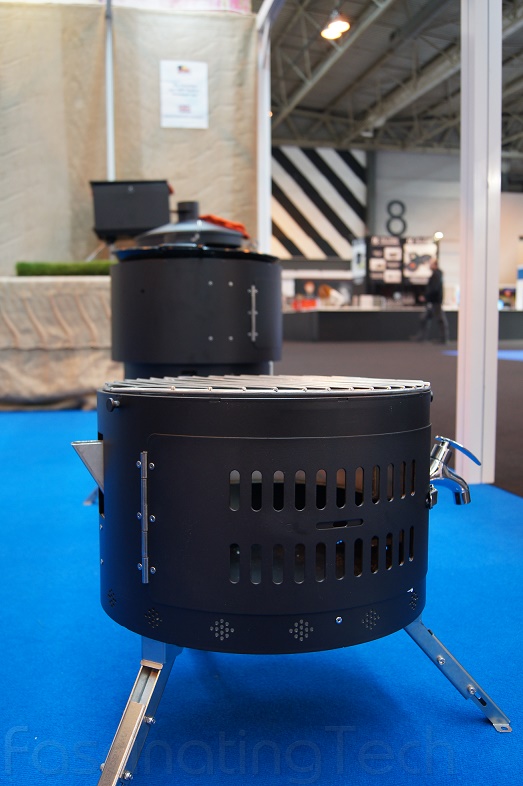
I liked this stand - The AquaForno is a portable, collapsible BBQ \ firepit \ patio heater with an integrated water contained in the fire area, giving access to hot water for teas or coffees or other hot beverages. The whole unit looks like an inverted truncated cone where all 3 sections collapses down into the main (top) drum for storage and transportation. When extended, the bottom area contains the fire (and kettle), the middle section allows for hot cooking while the top can cater for more delicate heat or keeping your burgers warm or even cooking pizza on top of the optional pizza stone. The device looks very sturdy balanced on its three retractable \ integral legs, and nearing 1 meter high at full extent allows for a comfortable cooking height. I hope to have a more in depth review in a later issue. During BBQ season. With a couple of friends and a few beverages. In the sun.
Align
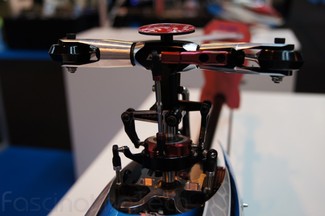
Align were presenting some very nice, high tech, high spec RC equipment including helicopters, quad-copters, multi- copters, controllers and gimbals. The ML690 Super Combo RM69001XT caught my eye with its 6 large rotors, camera gimbal, carbon fibre housing, GPS unit, and quick release battery plate - A serious piece of kit that is genuinely in reach of enthusiasts.
Powerup
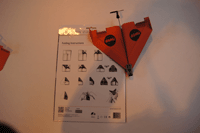
A true throwaway (and return) gadget - A smart-phone controllable propeller and prop that can be attached to paper aeroplanes, giving you the ability to control their flight up to 55 meters away for up to 10 minutes (on a 30 minute charge).
There are two main devices available, the controllable PowerUp 3.0, and the powered PowerUp Free Flight (2.0) - Both come with a battery powered propeller, but the 3,0 can sync with iOS and Android devices and be controlled, while the 2.0 allows the propeller to be charged and then flown with no external control (for up to 30 seconds). The packages come with a number of spare parts (handy), with some of the 3.0 components being made from carbon fibre.
XDream
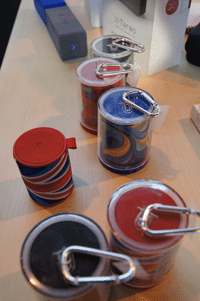
A brief stop over here, looking at the new range of vibration speakers and power units.
The vibration speakers allow any resonant surface to act as a speaker, a polystyrene cup, a window, or even a table top; The more resonant, the louder the sounds produced. The devices seemed to come a long way since their previous releases with deeper bass and less tinny sounds being evident - This may be partially due to the music being listened to, but there did seem to be a noticeable improvement in sound quality and volume.
Also presented were the latest versions of the XDream portable power units that can be pre-charged and used to power up phones and other light weight gadgets when needed. Devices are slim and stylish and come in a variety of styles and power ratings. If these were a music genre, they would be J-Pop.
Swann
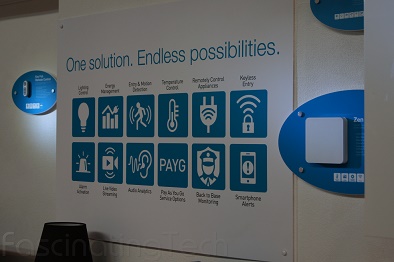
A little while was spent at the Swann stand where the latest versions of consumer accessible home security systems were being displayed. A lot of new technology was evident here with focus on the consumer kits and additional sensors for the wire-free, controllable secure home.
The SwannOne kits range from a the simple, but efficient, alarm starter kit through to the advanced home control kit and energy wise kit. All kits and accessories are well made and unobtrusive (except when you want them visible) and have a wealth of technologies on board.
The Smart Home items allow connected devices to be powered on or off via wireless technology, while the home security components can be controlled and viewed remotely, and allow the upload of video footage to a secure cloud instance for offline viewing or archiving. Some of the technology can also identify key sounds (glass breaking, alarms sounding, babies crying, gunshots) and take appropriate action - sound an alarm, or call a remote monitoring station.
A full review on the items available will likely be forthcoming.
Intermission
http://thedigitallifestyle.com/w/index.php/category/podcast/ (Episode #495)
Time for a reasonably priced cappuccino, not-so-reasonably-priced apricot Danish, and my first podcast.
Centre for Computing History
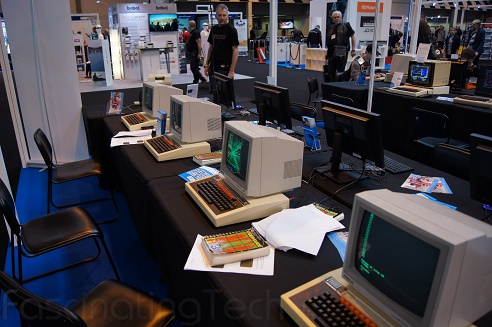
Another trip down memory lane - Commodor PETs, Acorns, Apple Macintosh, Binatone Master MK IV. It was good to see people under the age of 30 trying some of the kit. Yes... Not that long ago we thought 48 KILOBYTES and 8 COLOURS were cutting edge..(EDITOR: That much!)
Yuneec
Yuneec were showing off some very nice muli-copter rigs and controllers. I believe two of the main devices on show were the H920 Tornado multi-rotor platform (carbon fibre body, 5KG load weight with gimbal, up to 40 minutes flight time) and the ST24 base station (24 channels with 5.8GHz video downlink, with the power to keep the feed uninterrupted) - A serious collection of components combined allowing for First Person View capabilities on the 7" integrated base station screen, A flight simulator, or a compatible Android device.
HP Sprout
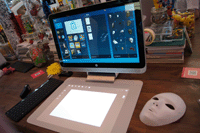
My final stop... and one that was quite disappointing. I had heard good things about the technology, how it was compact, cheap (in USA), able to image and 3D render items placed in front of it, but in reality... it was not as good as I thought it would be. I will admit that this may be due to the newness of the technology and the applications, and it can only really get better, but this demo was a little underwhelming.
Technology
The unit was sleek - A nice 23" HD touch screen with a work mat attached underneath (again, multi-touch) and a set of cameras sticking out above the monitor and focusing on the work area. All in "glacier" white framing with a powerful i7 processor and TB of HDD (minimum standard nowdays?).
3D
The 3D imaging and mapping software was bare bones - It was quick at registering and imaging the prop placed on the work surface, and the output was ok, but I cannot see a market for the software in its current state. 3D modellers would likely want something this quick, but better resolution and able to produce standard 3D format files; while the home user... may not want to use this software.
I could see a potential audience in the education area - Introductions to 3d modelling, computer graphics and the like - But then good quality hand scanners could be bought for a comparable price and be usable across (plug 'n' play) multiple workstations.
Edge detection in the software was pretty poor - The bottom edges of the prop furthest away from the imaging cameras were very jagged (possibly due to poor optical resolution at those points?) and the software that come with the product could not help to amend this. Elements not connected to the main image were very easy to remove but the software as-is was pretty limited.
Part of my disappointment may be due to the information available to me at the time. while writing this I took time to look at the Sprout website; the videos and articles hint at more that could be done with the kit, and the 3d software, than was discussed during the session. It would be intresting to see how this pans out.
However, I can see a use for this for digital artists wishing to sample textures and objects in order to bring them into a digital workspace. Instead of taking images by camera, then uploading them into the workspace, the unit could do this in situ where the object allows.
Multitouch Work Surface
I do like the idea of the touch sensitive mat - I originally believed that the cameras above the mat were monitoring the movements visually and translating these into movements in software, but it was clarified that the mat itself was touch sensitive (20 point multi-touch).
This could be useful in a number of areas; Replacement or enhancement for digital tablets (no extra space required), use in schools (easier and safer? to clean than a screen), People with limited movement capabilities (easier to interact with a horizontal mat than a vertical screen)
Although I am also thinking of augmented reality sandboxes...
